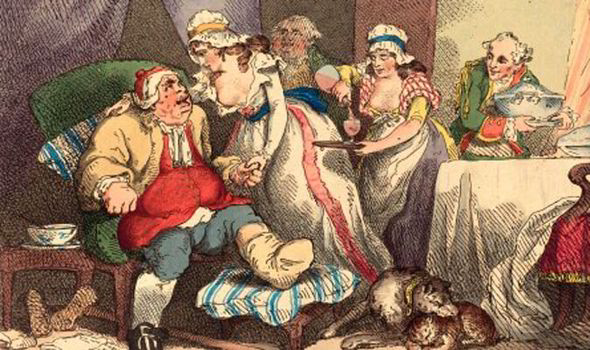Last updated on January 29th, 2023 at 08:56 pm
Egyptians were the first to recognize gout as a disease in 2640 BC. Hippocrates recognized its debilitating nature by the fifth century BC, calling it the “unwalkable disease.” He often used aphorisms, which still ring true to this day, to describe it.
He referred to gout as the “arthritis of the rich” or the king’s disease because he believed only the affluent fell prey to the condition.
Since gout was often the result of upper society’s overindulgent diets of meat and alcohol, it certainly isn’t hard to see why he came to such a conclusion.
In reality, this painful condition is caused by an excess of uric acid in the body and can happen to anyone regardless of socioeconomic status.
This article delves into gout’s strange yet intriguing history, a familiar yet thankfully treatable disease nowadays.

A Brief History of Gout
The Roman surgeon Galen was the first to identify tophi as crystallized chunks of uric acid (monosodium urate) that form around the joints, causing pain and swelling.
Tophi can occur in multiple body areas and lead to advanced gout if left untreated.
Podagra, a manifestation of gout, was first used by a Dominican monk named Randolphus of Bocking in 1200 AD. In Greek, pod means “foot” while agra translates to “seizure” or “to take.”
The term also has Latin roots, with the word gutta translating to “drop.”
It was so named because of the medieval belief that when one of a person’s four “humors” were imbalanced ( a concept rooted in Shakesperian cosmology), the imbalance would cause one of them to “drop” into a joint.
The subsequent painful inflammation and swelling were believed to be its symptoms. Famous English physician Thoman Sydenham elaborated on the condition’s nature and symptoms when he was diagnosed with gout and renal disease.
There was a time in the 1900s when it was acceptable to suffer from gout since it labeled the socially and politically affluent as powerful figures in society.
What Is Gout?
When a person’s uric acid levels are abnormally high, it leads to hyperuricemia, which causes gout. Gout occurs when uric acid deposits appear in and around the joints.
These deposits can collect in the wrists, fingers, big toe, or knees, causing these areas to swell up and become painful.
Gout is an inflammatory form of arthritis. It’s mainly caused by individuals consuming food that is high in purines. When such food is eaten in excess, the body produces more uric acid as it digests purines.
Incidents of gout in Asia aren’t as high or severe since people’s diets mostly consist of rice and vegetables. However, it’s more common in North America and Western Europe, where people’s diets contain more meat and seafood, two food items that can contribute to hyperuricemia and gout.
Since more people worldwide can afford moderately comfortable to affluent lifestyles, their diets majorly consist of meat, seafood, and alcohol (beer is known to have the highest purine content).
Two thousand years ago, physician Aretaeus of Cappadocia described the symptoms of gout quite aptly as “hot needles being slowly pushed into your flesh. Every step’s an agony, and the weight of a simple bed sheet is unbearable.”
Is Gout Curable?
Gout can be significantly reversed if an individual drastically alters their lifestyle. Decreased levels of purines, increased hydration, and moderate physical activity can help gout patients in the long term.
Several anti-inflammatory and pain medications on the market can also help alleviate the crippling effects of gout.
In Ancient Greece, Byzantine physician Alexander of Tralles used colchicine (a plant extract derived from the autumn crocus) to treat gout. It wasn’t used for several years until it resurfaced in the mid-1700s when Baron Anton de Stork, an Austrian physician, rediscovered its therapeutic properties.
Gout can be identified by the hard nodules that form under the skin where the joints meet. Gout is a painful and destructive disease that can cause significant damage to the bone cartilage if left untreated.
Medicines and sometimes surgery (in serious cases when mobility is hampered) can help eliminate uric acid crystals and offer relief.
Benjamin Franklin was known to use colchicine to ease his gout flares.
History of Gout Medication
AB Garrod was one of the first to identify that a low-purine diet helped control hyperuricemia. Haig later confirmed this in experiments he conducted on himself between 1894 and 1897.
The most important medical advancement in treating hyperuricemia was the development of allopurinol. It was one of the first xanthine oxidase inhibitors (inhibiting uric acid synthesis in the body) formulated and studied by George Hitchings and Gertrude Elion.
They were awarded the Nobel prize in 1988 for their work in developing the drug alongside groundbreaking discoveries in drug treatment.
Similar medicines, such as oxypurinol and febuxostat were recently used in clinical trials for chronic gout and hyperuricemia. Thanks to modern science, studying this disease has given doctors and medical experts various viable treatment options.
Preventative Methods for Gout
Oftentimes, the food and drinks we consume contribute to our diseases. The best way to avoid gout is to be careful about what you put in your body. Foods such as red meat, shellfish, poultry, and processed meat can lead to gout when eaten in excess. Alcohol, high fructose corn syrup, and sugary snacks can also increase uric acid in the body.
Ideal Levels of Uric Acid
The ideal uric acid level in the body is between 2.4 and 6.0 mg/dL for females and between 3.4 and 7.0 mg/dL for males. To keep track of uric acid levels, patients are advised to undergo basic blood and urine tests.
Those with mild to severe gout are often prescribed nonsteroidal anti-inflammatory drugs (NSAIDs) to help with pain and inflammation.
Uric Acid Statistics
Gout may have once been called the king’s disease, but today it affects millions worldwide. In 2017, there were as many as 41.2 million prevalent cases of gout, with 1.3 million living with it as a disability.
These numbers are predicted to increase if individuals don’t adopt more mindful dietary and lifestyle changes in the coming years. If history has taught us anything about gout, it’s that gout is treatable and doesn’t have to diminish one’s quality of life.

